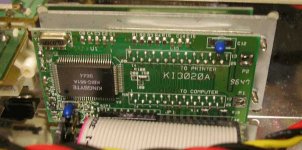RickNel
Veteran Member
I picked this up from my usual supplier of quality vintage goods - the tip shop.
No markings or brands. IEC AC input for 12v/5v PSU and a parallel/IDE multiplexer of some sort, housing a CD-ROM with RCA stereo audio out.

The case is very solid, radiation shielded, little fan next to the CD-ROM, looks like meant to sit under a CRT monitor or similar heavy box.

Rear labels on DB25 sockets are "Printer" and "IDE Port"

Logic chip on the multiplexer board is KingByte KBIC-051A / 9644. Made in Taiwan.
Nearest I could get from Google is that KingsByte made parallel/IDE interfaces for various non-name peripherals.
This looks like it might have been designed to go with something like a Tandy or Commodore or the like?
The case top has small square recess where a proprietary logo might be expected - but it's empty.
There are some drivers on DriverGuide that might work for some older DOS-based system before ATAPI standards - Win 3.1 or so - but I don't know how IDE would interface to a DB25 - was there a special standard or would the driver assume standard LPT pinout?
If this is not worth preserving as an external CDROM for my oldest machines, the case with PSU could be re-used as a handy enclosure for a modern mini single-board device of some sort.
Rick
No markings or brands. IEC AC input for 12v/5v PSU and a parallel/IDE multiplexer of some sort, housing a CD-ROM with RCA stereo audio out.

The case is very solid, radiation shielded, little fan next to the CD-ROM, looks like meant to sit under a CRT monitor or similar heavy box.

Rear labels on DB25 sockets are "Printer" and "IDE Port"

Logic chip on the multiplexer board is KingByte KBIC-051A / 9644. Made in Taiwan.
Nearest I could get from Google is that KingsByte made parallel/IDE interfaces for various non-name peripherals.
This looks like it might have been designed to go with something like a Tandy or Commodore or the like?
The case top has small square recess where a proprietary logo might be expected - but it's empty.
There are some drivers on DriverGuide that might work for some older DOS-based system before ATAPI standards - Win 3.1 or so - but I don't know how IDE would interface to a DB25 - was there a special standard or would the driver assume standard LPT pinout?
If this is not worth preserving as an external CDROM for my oldest machines, the case with PSU could be re-used as a handy enclosure for a modern mini single-board device of some sort.
Rick
